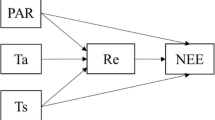Abstract
Geostatistical prediction and simulation are being increasingly used in the earth sciences and engineering to address the imperfect knowledge of attributes that fluctuate over large areas or volumes—pollutant concentration, electromagnetic fields, porosity, thickness of a geological formation. Central to the application of such techniques is the need to know the spatial continuity, knowledge that is commonly condensed in the form of covariance or semivariogram models. Their preparation is subdivided here into the following steps: (1) Data editing, (2) Exploratory data analysis, (3) Semivariogram estimation, (4) Directional investigation, (5) Simple modeling, (6) Nested modeling. I illustrate these stages practically with a real data set from a geophysical survey from Elk County, Kansas, USA. The applicability of the approach is not limited by the physical nature of the attribute of interest.










Similar content being viewed by others
References
Barnes RJ (1991) The variogram sill and the sample variance. Math Geol 23:673–678
Chilès J-P, Delfiner P (1999) Geostatistics—modeling spatial uncertainty. Wiley, New York, 695 p
Collins DR (1999) User’s guide for the LEO system, version 3.9. Kansas Geological Survey Open-File Report 99–48, 13 p
Deutsch CV, Journel AG (1998) GSLIB—geostatistical software library and user’s guide. Oxford University Press, New York, 369 p and 1 compact disk
Goovaerts P (1997) Geostatistics for natural resources evaluation. Oxford University Press, New York, 483 p
Isaaks EH, Srivastava, RM (1989) Introduction to applied geostatistics. Oxford University Press, New York, 561 p
Jian X, Olea RA, Yu Y-S (1996) Semivariogram modeling by weighted least squares. Comput Geosci 22:387–397
Journel AG, Huijbregts CJ (1978) Mining geostatistics. Academic, London, 600 p
Kitanidis PK (1997) Introduction to geostatistics: applications to hydrology. Cambridge University Press, New York, 249 p
Lam C-K (1987) Interpretation of statewide gravity survey of Kansas. Kansas Geological Survey Open-File Report 87–1. 213 p and 6 plates
Olea RA (1999) Geostatistics for engineers and earth scientists. Kluwer, Boston, 303 p
Pannatier Y (1996) VARIOWIN: software for spatial data analysis in 2D. Springer, New York, 91 p
Press WH, Teukolsky SA, Vetterling WT, Flannery BP (1992) Numerical recipes in fortran, 2nd edn. Cambridge University Press, New York, 963 p
Tong H (1983) Threshold models in non-linear time series analysis. Springer, New York, 323 p
Verly G (1986) Multigaussian kriging—a complete case study. In: Ramani RV (ed) Proceedings of the 19th APCOM international symposium, Society of Mining Engineers, Littleton, Colorado, pp 283–298
Webster R, Oliver MA (1992) Sample adequately to estimate variograms of soils properties. J Soil Sci 43:177–192
Xia J, Yarger H, Lam C-K, Steeples D, Miller R (1992) Bouguer gravity anomaly map of Kansas. Kansas Geological Survey Map M-31
Acknowledgements
I am grateful to John H. Doveton and two anonymous reviewers for critical reading of the manuscript that resulted in suggestions that improved the presentation.
Author information
Authors and Affiliations
Corresponding author
Rights and permissions
About this article
Cite this article
Olea, R.A. A six-step practical approach to semivariogram modeling. Stoch Environ Res Ris Assess 20, 307–318 (2006). https://doi.org/10.1007/s00477-005-0026-1
Published:
Issue Date:
DOI: https://doi.org/10.1007/s00477-005-0026-1




